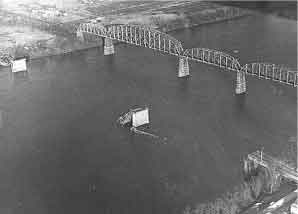So-called by Point Pleasant-area residents viewing its silvery aluminum paint for the first time, the Silver Bridge was designed by J.E. Greiner Company
and built by Gallia County Ohio River Bridge Company (later West Virginia-Ohio Bridge Company) and its subcontractor, U.S. Steel’s American Bridge Company.
A two-lane, 1760-foot-long eyebar suspension bridge with a 700-foot main span 102 feet above the bottom of the Ohio River channel and two 380-foot anchor
spans, it was completed in one year, opening to traffic on Memorial Day 1928.
Although the original design had called for conventional wire cables, an eyebar chain design—bid as an alternate—came in at a lower price. The bridge was
described in the June 20, 1929 Engineering News Record as “the first of its type in the United States” (another of the same design, the Hercilio
Luz Bridge in Florianopolis, Brazil, was built in 1924 and is reportedly still in service; the Silver Bridge’s twin—another toll facility, also known as
the Hiram “Hi” Carpenter Bridge—was constructed 75 miles upstream at St. Marys in 1928, using different approaches but the same engineer, contractor,
fabricator and shop drawings).
Unlike three chain-link suspension bridges at Pittsburgh and others throughout the world, particularly in Europe, the Silver Bridge’s anchorages were, according
to the magazine, “unique (in their) use of heat-treated eyebar chains, portions of which form parts of the top chords of the stiffening trusses.” In this
arrangement, each chain link consisted of a pair of bone-shaped 2x12-inch bars, varying in length from 45 to 55 feet by their position on the bridge, with
11-inch-diameter pins connecting the links through the “eyes” at the ends of the bars. These chains constituted the upper chord to a Warren-type stiffening truss
in the seven panels of each side span and 12 panels of the center span.
Perhaps ominously, the Engineering News Record article also noted the fact that it was not possible to make “any adjustments in the chains, hangers or
trusses after erection.”
Following West Virginia’s purchase of the Hi Carpenter Bridge in 1937 and removal of its tolls in 1946, the Silver Bridge was bought by the state for $1.04 million
in 1941 and made toll-free ten years later on December 31.
Inspections, which had been done by the private owner from 1928 to 1941, were taken over by the State Road Commission. State standards were followed during inspections,
which were noted in 1959, 1963 and 1964. Following an inspection in 1965, some $30,000 in recommended repairs were completed. Two more inspections were done in the
summer of 1967, with a final visit by the Commission’s area maintenance engineer on December 6.

At 5 p.m. on December 15, 1967, eyewitnesses recall, there was a loud gunshot-like noise and, “folding like a deck of cards” in less than 20 seconds, the entire
1460-foot suspended portion of the Silver Bridge collapsed into the river, taking with it 32 vehicles and 46 victims, including two whose bodies were never found.
Almost immediately arrangements were made with a local ferry to take vehicles—which had averaged 3,500 to 4,000 daily on the bridge, including 20 percent truck
traffic—between rapidly prepared landings on the Ohio and West Virginia shores. A shuttle service began on the New York Central Railroad Bridge immediately upstream
and vehicles were also detoured 14 miles north to the Pomeroy Bridge or even further south to a new bridge carrying US 52 over the river at Huntington.
On February 7, 1968, with economic losses that were estimated at $1 million a month, President Lyndon Johnson ordered a federal-state program for immediate
reconstruction. Design on the substructure, superstructure and approaches was done by three consulting firms, with the superstructure designer saving precious
time by utilizing preliminary drawings previously prepared for the I-20 Mississippi River bridge at Vicksburg, altered to fit the topography.
The National Transportation Safety Board began an investigation immediately, along with a temporary closure of the Silver Bridge’s twin at St. Marys.
The Presidential Task Force on Bridge Safety also looked into the collapse and conducted a national survey on bridge safety that included analysis of procedures
and standards used to insure the safety of other bridges throughout the country and development of recommendations to assure the safety of the public.
On April 6, 1971, the Safety Board finally issued its determination of the cause of the collapse—“a cleavage fracture in the lower limb of the eye of eyebar 330
at joint C13N of the north eyebar suspension chain in the Ohio side span. The fracture was caused by the development of a critical-size flaw over the 40-year life
of the structure as the result of the joint action of stress corrosion and corrosion fatigue.”
Laboratory work identified the failure sequence as “a brittle fracture of the lower half of the eye, then a ductile fracture of the upper half, …resulting (in)
pulling… the companion eyebar off the pin which had connected it with the fractured eyebar.” It concluded that, “With the north …chain thus broken, the structure’s
design made total collapse… inevitable.”
Noted in the report were findings that, in 1927, “stress corrosion and corrosion fatigue were not known to occur in the bridge materials used under conditions of
exposure normally encountered in rural areas” and that the location of the minute crack “was inaccessible to visual inspection” and could not have been detected
“by any …method… without disassembly of the eyebar joint”—a practical impossibility.
Among the Safety Board’s recommendations to the US Secretary of Transportation were expanding or beginning research programs aimed at such areas as identifying
susceptible bridge construction materials and developing new inspection equipment and safeguards in selecting materials, design and fabrication of future bridges.
Its final recommendation was to “explore alternatives” to assure that federal bridge safety standards be applied to all highway bridges (not just the 165,000 on
the federal system but the other 398,000 structures ) and “consider proposing a program of federal-aid funding.”